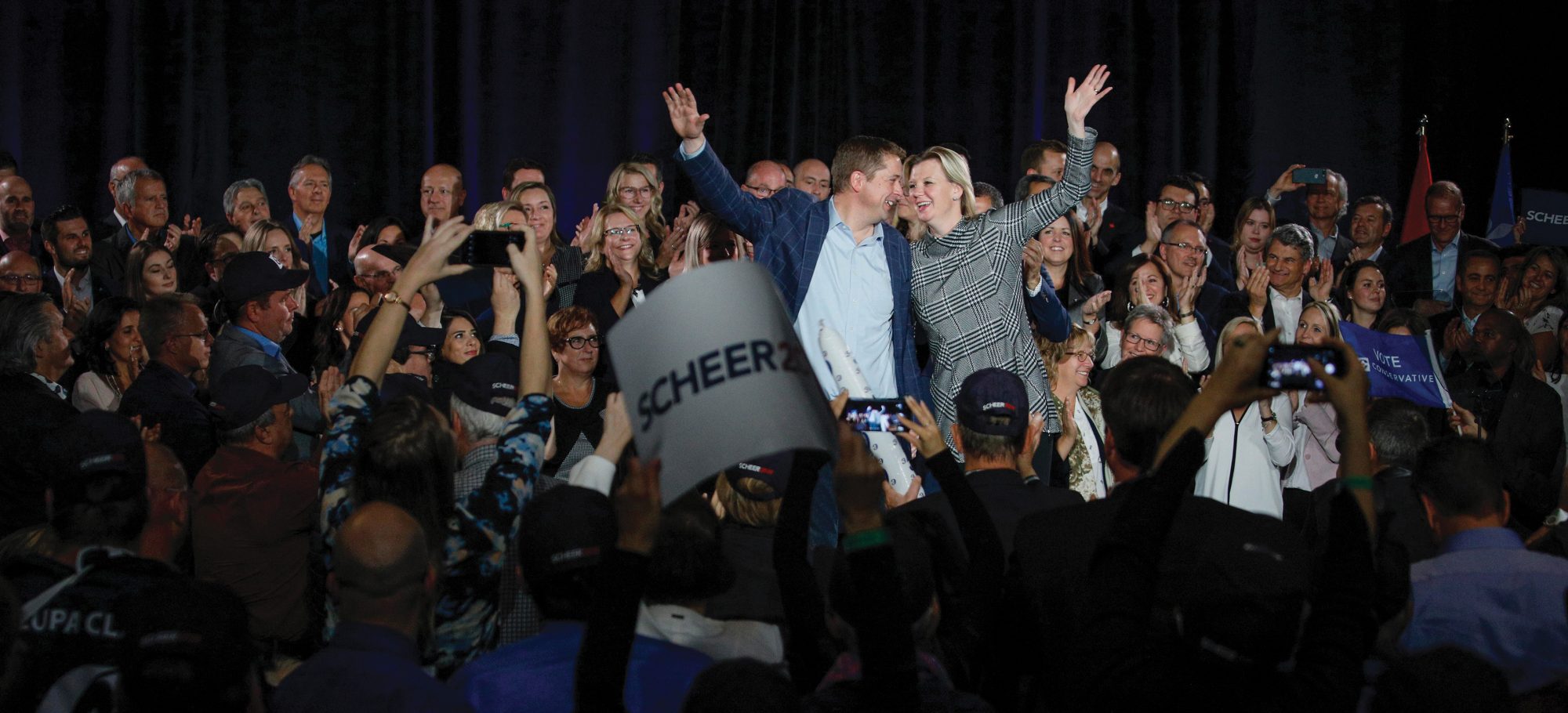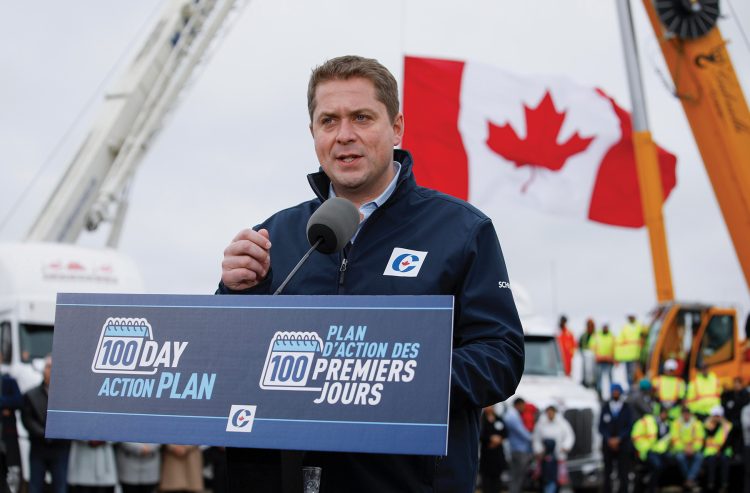Word to Fellow Conservatives: Revive the ‘Tory Syndrome’ at Your Peril

Veteran Conservative strategist Yaroslav Baran notes some real lessons to be learned from the 2019 campaign, but argues that clamouring for Scheer’s head will only backfire on the party he leads.
Yaroslav Baran
Two major questions were left behind after the dust settled on election night: how will Prime Minister Trudeau handle Western alienation and his absolute shut-out from Alberta and Saskatchewan? And what’s next for Conservative Leader Andrew Scheer?
Within days of the election, a handful of internal voices emerged, calling the Conservative campaign a failure. Scratch the surface of those conservative operatives, and you see some obvious motives: most were key actors in the Maxime Bernier leadership campaign, still smarting from defeat, and some bitter for having been shut out of the Scheer circle for failure to concede the leadership gracefully. That said, some of those voices have a platform. And sometimes, when a small number makes noise—and nobody else rebuts—it might just catalyze something, so why not try? But what are the real risks to Scheer’s leadership, and what lessons should be learned from the 2019 campaign?
By any normal, objective measure, Andrew Scheer’s leadership should be even more secure following October 21st: He was one of only two party leaders to gain seats, he enlarged his caucus by a quarter, he knocked his tremendously charismatic and internationally popular opponent down to a minority, and he actually won the popular vote—he got more votes than Justin Trudeau.
Were the party rank and file disappointed not to have done better? Certainly. The only thing worse than losing is losing after it felt like you might have won. Was Scheer equally disappointed? You bet. But suggesting this dog can’t hunt? That’s a fanciful conclusion that falls somewhere between ignoring E-Day results, ignoring the lessons of history, and having an ulterior motive.
In 2004, then-Opposition Leader Stephen Harper accomplished a significant electoral feat. He squared off against Paul Martin—also an immensely popular Liberal leader and prime minister, widely heralded by the punditocracy as heading a political juggernaut that would reign for a generation. Harper knocked that juggernaut down to a minority, and two years later, replaced it with a minority government of his own. That same Harper went on from his initial 2004 “loss” to win three elections and govern as prime minister for nine years. Yet, at the time, immediately after the 2004 election, Harper was deluged with questions about his leadership abilities, his saleability beyond the Conservative base, his ability to actually win an election. The knives were out, with many saying “This dog can’t hunt.”
The Scheer detractors will point to exceptional circumstances: how could he have lost after the SNC-Lavalin deferred prosecution agreement scandal? After #blackface? While easy to forget 15 years later, similar questions were being asked in 2004 in the wake of the Sponsorship Scandal—the revelation of an elaborate kick-back scheme to the governing party by Liberal-friendly ad firms placing government-sponsored ads extolling the virtues of Canada and federalism following the 1995 Quebec sovereignty referendum. Perspective, therefore, is important. Scheer effectively did a replay of Harper’s move in 2004—except he also won the popular vote.
A sophisticated analysis would peel back that popular vote number and see that it also masks some serious regional distortion. More people voted for Scheer than for Trudeau, but if you take the over-efficient Alberta and Saskatchewan out of the equation, Scheer’s “rest of Canada” popular vote level drops to the high twenties. He will have to do better. As 338Canada.com’s Philippe J. Fournier points out, “Conservatives increased their vote share in 194 of 338 electoral districts (57 per cent) and lost ground compared to 2015 in the remaining 144 districts (43 per cent). However, out of those 144 districts where the Conservatives lost ground, no fewer than 139 are in Quebec and Ontario. The remaining five are located in B.C.’s Lower Mainland.”
In analytical terms: the regional and demographic divides that stereotype the division between Liberals and Conservatives are becoming more pronounced. In practical terms: The Conservatives will need to find a way to reverse that shift and appeal to the GTA, Vancouver, and Quebec if they want to form government.
What, then are the lessons for Scheer—to both deprive his detractors of oxygen, and to broaden his appeal for the next election?
Number one, while he has reconciled his personal social conservatism with the broader needs of government and Canadian society, he didn’t find a way to articulate that to the public until the very end of the campaign. It’s not as though Scheer is the first Catholic aspirant to the PM’s job. He eventually found the right words, but too many people found his earlier explanations on abortion and same-sex marriage ambiguous. The risk there is not so much alienating Canadians who have a different view (particularly as there’s nothing to challenge in his we ain’t going there message); the bigger risk is looking uncomfortable in his own skin, and looking uncomfortable discussing certain issues.

The second lesson is broadening the policy discourse. Hindsight is always omniscient. In a parallel alternate dimension, we might very well have been extolling his strategic genius for having laser-focused on affordability—talking about almost nothing else—as the recipe for his 2019 election triumph. It was not necessarily a bad strategic decision. All parties play to their strengths, and the party’s polling showed that cost-of-living anxieties played to the Tories’ favour. It just happened to not work. The obvious lesson is that voters in many swaths of the country expect a fully rounded platform—not one that hones in on a single key theme.
In fairness to Scheer, he did have a climate change platform—and even a compelling one. The campaign simply chose not to focus on that. Imagine a campaign where the Conservatives might have run the same affordability platform—complete with tax credits for children’s athletics and culture, tax deductibility of parental leave benefits, easier access to home ownership for millennials, and so on—but also a robust climate change message that the leader spoke to at every turn:
“We indeed have a climate emergency. The difference between me and Mr. Trudeau is that he wants to punish you—when you put gas in your car to drive the kids to soccer, when you buy groceries for your family, when you turn the heat on in winter. And that punishing you for those acts will force different choices, and that that will eventually save the planet. That’s bunk. I believe in the same approach as Barack Obama: we need to put a hard cap on all large final emitters, sector-by-sector, and curb emissions. And if they go over their caps, we will force a penalty—but a penalty that will go 100 per cent into new and better green technology research and development. That’s how you fight emissions. That’s how you fight climate change. Not by punishing consumers—by fighting emissions at source, and spurring more R&D for alternatives.”
The reality is that Scheer put tremendous effort into his climate plan. When people heard his plan, they liked it. But the Conservative campaign chose not to highlight it. The leader should have. Similarly, the campaign was virtually silent on Indigenous policy. This also betrays a blind spot of market research-driven campaigning. It may be true that Conservatives don’t traditionally win elections on their Indigenous platform, but it is also true Conservatives lose elections when they don’t have one.
In short, contemporary voters are sophisticated people interested in a variety of issues. Most are not so passionate about one policy space that it drives their entire voting decision. Most want to see a comprehensive plan—and a leader willing to talk about all aspects of public policy. In the days ahead, Scheer will be conducting a post-campaign analysis. These are among the findings he will be encountering. He would be wise to make his post-mortem activities inclusive—with mechanisms of genuine input for party members, and even visible meetings in different parts of the country to allow members to have their say. If he does this, he will be not only be fine, but empowered with broader insight and advice to do better in 2023.
For those yearning for a leadership review, a word of caution: every party leader has a first campaign. First campaigns are where one makes mistakes, learns, grows, and repositions for a second campaign. It’s where a team recognizes what it needs to do differently the next time around. If impatient Tories revive the old “Tory Syndrome” of ousting the leader after an initial kick at the electoral can, they’ll guarantee the next election will be someone else’s first campaign.
Contributing writer Yaroslav Baran, a principal of Earnscliffe Strategy Group, is a former chief of staff to the Government House Leader in the Conservative Harper government. He also ran Conservative Party communications through three national campaigns.
